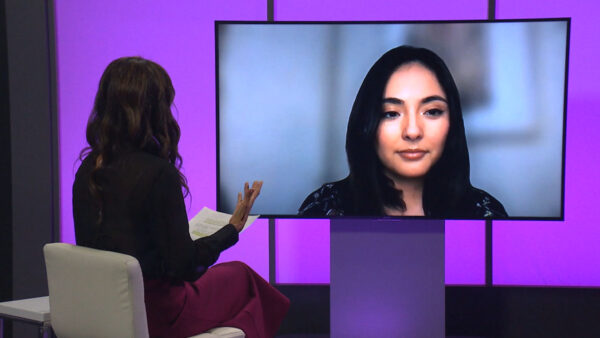Catholics in the United States will begin using the English translation of the Roman Missal on the first Sunday of Advent in November. Fr. John Muir, Associate Director for the Office of Worship with the Roman Catholic Diocese of Phoenix will discuss the changes in the missal.
Jose Cardenas: A new Roman Missal will be used in Roman Catholic liturgy around the world on November 27th. The Missal will have a new and more accurate English translation of particular parts of the mass. In September the diocese of Phoenix was one of the first to announce its intention to adjust its community policy by not offering consecrated wine at most masses. With me to talk about the changes is Father John Muir, associate director for the office of worship with the Roman Catholic diocese of Phoenix. Father John, welcome to "Horizonte."
John Muir: Good to be here. Thank you.
Jose Cardenas: We've got a few images to show right off the bat. This is actually the guide, it's not the missal that we're showing, and this is the guide to implementation of the new Roman missal. It looks like a very beautiful book. We have a picture of one of the inside pages as well. It looks quite frankly almost as thick as the new Roman missal which you have in front of you.
John Muir: Yes this, right here is the Roman missal itself, and the previous picture was a guide to implementation. Parishes all around English speaking world have been spending the last year preparing for; learning about the new English, but it's a beautiful image of one of the new English Missals.
Jose Cardenas: Which you have in front of you.
John Muir: That's right.
Jose Cardenas: One of the few in the diocese.
John Muir: This is hot off the press, yeah.
Jose Cardenas: There's real history to this. We've got a chart that the diocese has prepared on the time line of the preparation of what is now the third missal. It begins, it goes back to the 13, 1500s, and I want to focus on the right side of this chart, because this is kind of how we got where we are now. Beginning basically with Vatican 2.
John Muir: Yeah. That's right. Translating the mass, our sacred worship, into the vernacular. I just saw on the other column, it goes way back. Jesus gave us the basic words of the mass, he said this is my body this, is my blood over the bread and wine. He said that in Aramaic, it gets translated to Greek and about the third centuary goes into Latin, and now fast toward to the '60s, the Catholic church asked that that Latin of the mass would be translated into local languages or vernacular languages as we say --
Jose Cardenas: That's what gave us the second edition?
John Muir: Yes. We're on our third edition of the Latin now. Little minor changes. Most people have person experiencing in mass since the early '70s. In 1975 we had our first English version, in 1985 there were tweaks in the English, but beginning in the mid 80s the Bishops in the English speaking world, including the pope himself, John Paul the II, God bless John Paul II, were aware that some of the early translations going back to the early '70s were done so quickly, there were so many books to be translated, so many sacred rituals to be translated into all the languages of the world, they were done quickly and they were -- everybody knew pretty much they were going to have to be retranslated. From the mid 80s until just -- .
Jose Cardenas: I understand this particular translation has been 25 years in the making.
John Muir: Yeah. A lot of work done in the '80s and '90s was used in the last 10 years. Going back to 2001, that's when new principles were given to us by the pope, and the new translations were produced. But the work expands 25 years if not more. A lot of work.
Jose Cardenas: We've got a chart, provided by the diocese, that shows some of the changes, some seeming more substantial than others. In particular we've got the green, which has received a lot of discussion. Currently it's in response to the opening statement from the priest. And also with you and the new response is going to be, and with your spirit.
John Muir: That's the big change. Probably of all the changes that your average Catholic in the pew is going to notice, that's the big one. The very beginning of mats, after the sign of the cross, the lord be with you, and we've been saying since the '70s and also with you. The new English says you say is and with your spirit. Which is pretty different. In Latin people are familiar with the words. [speaking Latin] Folks who go to mass in Spanish, it's very, very similar. The word spirit isn't there. Now in English we're closer to what folks all around the world and all the different languages have been saying and with your spirit.
Jose Cardenas: Let's talk about a couple other changes. One has to do with the penitential act. Right now we say I've sinned through my own fault. Now its going to be - I have greatly sinned…through my fault, through my fault, through my most grievous fault… Why that change?
John Muir: Interestingly enough, what you'll see is also the triple striking of the heart with the words through my fault, through my fault, through my most grievous fault. Some folks this strikes them as sort of MACABRE, why are we pounding on our chest and talking about how bad we are? The whole mass is a transforming journey. It begin was calling to mind how far we are from God, and then confessing that to our brothers and sisters, to the saints and angels and drawing into this whole process of transformation. And so for us as Catholics it's a happy moment when we're being honest with ourselves, calling Him through our sins and entering into the flow of the mass.
Jose Cardenas: We're running out of time. Let me get to what "The New York Times" says is the most significant change. It has to do with the Creed. This is a replacement of ‘one in being with the father' with the phrase, ‘consubstantial with the father'. I'm not sure anybody knows what that is.
John Muir: I agree. Who says the word consubstantial? There was a big battle over this in the fourth century. Consubstantial is a strange word, but it's a specific word and it's strange for a reason, it refers to what Catholics believe about the Lord Jesus Christ. That he has the same substance as the father, meaning he is god, he shares the divine nature with god the father and he has a human nature, so it's --
John Muir: Father John, I apologize, we've only got a few seconds left. I at least want a quick statement from you on the changes with respect to the consecration of the wine. It won't be offered as regularly as it was before. We've got about 15 seconds. We'll have you back on the show to discuss it more.
John Muir: Basically the diocese of Phoenix is simply trying to become more in line with what's happening around the world, which is not necessarily having communion every day, but frequently. It's not being taken away from Catholics.
Jose Cardenas: It will still be available on some occasions.
John Muir: Absolutely.
Jose Cardenas: On that note we'll end our interview, but we'll have you back to talk about that. That is our show for tonight. From all of us here at "Horizonte," I'm Jose Cardenas. Have a good evening.
Fr. John Muir:Associate Director, Office of Worship with the Roman Catholic Diocese of Phoenix;























